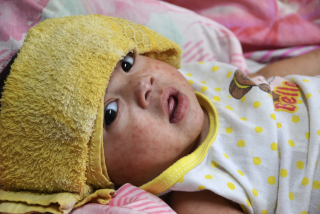Flu vaccination in school kids helps protect everyone
- Share via
Giving flu vaccines to as many school-age children as possible, by delivering it at school, for example, can help protect an entire community from flu, according to a new study.
Researchers led by Dr. W. Paul Glezen at Baylor College of Medicine created a study in which live attenuated influenza vaccine, which is a nasal spray, was offered to children at elementary schools in eastern Bell County, Texas, in the fall and early winter of 2007. Almost 48% of the elementary-school children were vaccinated. The researchers then recorded cases of flu infection that season that were severe enough to require medical care in the hospital, clinic or emergency service. The intervention community was compared with a similar community in which flu vaccination took place in the usual manner.
Despite the fact the vaccine that year was not a good match for the actual flu viruses that emerged, the study found that systematically immunizing the school kids helped everybody except people in the 12-to-17 age group. For example, compared with the non-study site, children younger than age 5 had a 6% lower rate of flu cases severe enough to require medical treatment and children ages 5 to 11 had an 8% reduction. People ages 18 and older had reductions in these severe flu cases that ranged, depending on their age group, from 10% to 15% compared with the other community.
“The indirect benefit that we measured was remarkable considering the circumstances,” Glezen said.
Many previous studies have shown that when a certain percentage of the population -- usually a specific group of people -- can be vaccinated against a virus, such as measles, pertussis or flu, a “herd” immunity is created that keeps the virus from circulating widely.
“The theory is that, for diseases passed from person to person, it is more difficult to maintain the infection when large numbers are immune,” wrote Dr. Edward B. Lewin, a pediatrician, in a commentary accompanying the new study. “The more individuals who are immune, the lower the chance that a susceptible person will come into contact with an infectious person.”
Lewin describes school children perfectly as “centrifugal spreaders” of the flu. They have the highest attack rates, have the worst hygiene and can excrete flu vaccine longer before becoming ill and after illness. Targeting this group makes a lot of sense.
The study points to more efficient and effective vaccine strategies that could be used in the future. “School-based clinics will deliver vaccine to the population with the highest infection rates each year,” Glezen said. “We would also recommend that employers offer vaccine to their employees in the workplace. . .If vaccine can be delivered early and systematically to the groups most likely to spread the infection in the community, we will make progress.”
The study and commentary appear in the December issue of the Journal of Infectious Diseases.
Related: “Why you need a flu shot -- again”
Return to Booster Shots Blog.






